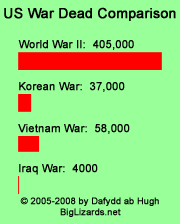November 24, 2005
WHO Are You?
Commenter KarmiCommunist, in the comments to my previous post, kindly provided the URL to the actual WHO report itself: WHO Multi-country Study on Women's Health and Domestic Violence against Women. A deeper look into this document both confirms my earlier guess (about the prevalence of violence against women in Japan compared to the other countries on that list) and also, it turns out, demonstrates the second feminist fallacy I discussed: the "all inclusive final term."
To forestall the inevitable, nothing here is meant to minimize the effect of physical and sexual violence against women. Rather, the point is the way it is reported: the explosive headline in the Reuters story, which does not bother mentioning that the survey was by and large conducted in the Third World; and the refusal by Reuters to note that the numbers for Japan -- the only member of western civilization included -- were far, far lower than the numbers of the other countries that truly drove the sad results of this survey.
As an aside, I also find it illuminating that WHO chose not to study domestic violence but only domestic violence against women. The reason this distinction is important is that it would tell us whether the violence was misogynistic in origin, or whether the particular culture is simply more accepting of partner-violence in general. The very title of the report implicitly concludes the violence is of the first (anti-woman) type. The fact that they chose from the very beginning not to study violence by women against men tells me that the purpose of the study was less to help individual victims of domestic violence (male or female) than to promote a feminist agenda... a conclusion rendered all the more believable by past WHO and UN positions on feminism. More on this anon.
But let's get to the specifics...
From page 5 (page 15 of the pdf):
The results indicate that violence by a male intimate partner (also called “domestic violence”) is widespread in all of the countries covered by the Study. However, there was a great deal of variation from country to country, and from setting to setting within the same country. Whereas there was variation by age, by marital status and by educational status, these sociodemographic factors did not account for the differences found between settings. The wide variation in prevalence rates signals that this violence is not inevitable.
The proportion of ever-partnered women who had ever experienced physical or sexual violence, or both, by an intimate partner in their lifetime, ranged from 15% to 71%, with most sites falling between 29% and 62%. Women in Japan were the least likely to have ever experienced physical or sexual violence, or both, by an intimate partner, while the greatest amount of violence was reported by women living in provincial (for the most part rural) settings in Bangladesh, Ethiopia, Peru, and the United Republic of Tanzania. Yet even in Japan, about 15% of ever-partnered women reported experiencing physical or sexual violence, or both, at some time in their lives. For partner violence in the past year, the figures ranged from 4% in Japan and Serbia and Montenegro to 54% in Ethiopia.
So now that we know that, far from "one out of 6" women in Japan experiencing domestic violence each year, the actual figure is one out of twenty-five, let's ask what, exactly, the WHO considered "violence."
Prevalence estimates of physical and sexual violence were obtained by asking direct, clearly worded questions about the respondent’s experience of specific acts.
In other words, this is a self-report survey... which is important to bear in mind, as none of the claims are substantiated. Here are the types of incidents they asked about; note that I have rearranged these incidents in order to make a point. The list in the order WHO presents it in the pdf can also be found on page 5, as with the quotation above.
To measure "physical violence," the women were asked whether a current or former partner had ever done any of the following:
- threatened her with, or actually used a gun, knife or other weapon against her
- hit her with a fist or something else that could hurt
- kicked, dragged or beaten her up
- choked or burnt her on purpose
- slapped her, or thrown something at her that could hurt her
- pushed or shoved her
When broken down by severity, the difference between Japan and the other countries becomes even more stark. Although the report doesn't tell us the exact number in each country self-reporting each particular act of "violence," they do divide into "moderate" and "severe," with the former being slapped/thrown and pushed/shoved, while the latter being everything else. In Japan, only 4% of women reported ever experiencing "severe physical violence" (by this definition) from a partner in their lifetimes.
If we assume the same ratio of violence in the last year to violence in lifetime (4::15), that would mean that only about 1% of Japanese women would have reported experiencing "severe physical violence" from a partner in the last twelve months.
The most common act of violence experienced by women was being slapped by their partner, from 9% in Japan to 52% in provincial Peru. This was followed by being struck with a fist, for which these two settings again represented the extremes (2% and 42%, respectively). In most places, between 11% and 21% of women reported being hit by a partner with his fist.
The actual conclusion is not so explosive after all and barely even worth noting: countries that have enormous levels of violence in general will also have enormous levels of violence (and sexual violence) against women. But it wouldn't be as useful to the feminist agenda to write the more accurate version of the story; the more lurid version serves the purpose of attacking patriarchy so much better!
And that, I suspect, is the underlying purpose of such studies, even on the part of the World Health Organization itself: if not, why lump Japan, a civilized country, into what is actually a study of violence in countries that are perpetually in a state of crisis? Why include being "pushed" in the same questionnaire as being shot or stabbed, and why break down the results only in the body of the report -- the part few will ever read?
In fact, the very first recommendation made by the WHO study's final chapter explicitly calls attention (and demands international compliance) to the long history of gender-feminist UN framework agreements, treaties, and resolutions (I previously defined gender-feminism, paraphrasing Christina Hoff Sommers, as "the gynocentric view that girls are good and boys are bad"). Presumably, this study is intended to fit into the outline of establishing a feminist agenda across the globe:
Considerable progress would be realized if governments complied with human rights treaties and international agreements that they have already ratified, such the Convention on the Elimination of All Forms of Discrimination against Women (1979), the United Nations Declaration on the Elimination of Violence against Women (1993), the 1994 Programme of Action of the International Conference on Population and Development (ICPD) (24), the 1995 Declaration and Platform for Action of the Fourth World Conference on Women (the “Beijing Declaration”) (7), and the 2000 Millennium Declaration and Development Goals (25).
Governments should strive to harmonize their legislation with these commitments and bring about the necessary changes in national laws, policies and programming. Advocacy for gender equality and human rights, and monitoring of national progress towards international commitments, need to be strengthened.
Consider that first convention, the Convention on the Elimination of All Forms of Discrimination against Women. Among other things, that convention demands legislation to change cultures to eliminate "stereotyped roles for men and women," (article 5), and it also countenances affirmative action, denying that such constitutes "discrimination" (article 4).
The 1995 Beijing Declaration explicitly affirms "the right of all women to control all aspects of their health, in particular their own fertility," a fairly clear declaration of absolute abortion rights (paragraph 17). Here are a few more paragraphs, to give somewhat of a flavor of the orientation of these various UN agreements:
17. Local, national, regional and global peace is attainable and is inextricably linked with the advancement of women, who are a fundamental force for leadership, conflict resolution and the promotion of lasting peace at all levels
18. It is essential to design, implement and monitor, with the full participation of women, effective, efficient and mutually reinforcing gender-sensitive policies and programmes, including development policies and programmes, at all levels that will foster the empowerment and advancement of women
28. Take positive steps to ensure peace for the advancement of women and,recognizing the leading role that women have played in the peace movement,work actively towards general and complete disarmament under strict and effective international control, and support negotiations on the conclusion, without delay, of a universal and multilaterally and effectively verifiable comprehensive nuclear-test-ban treaty which contributes to nuclear disarmament and the prevention of the proliferation of nuclear weapons in all its aspects
(I'm not sure how an "effectively verifiable comprehensive nuclear-test-ban treaty" relates specifically to women, but that's the UN for you.)
The bulk of the Fouth World Conference for Women report (all the stuff following the Beijing Declaration) is labeled "Platform for Action." Among many, many, many other action items, this platform demands:
- A cabinet-level position devoted to "responsibility for the advancement of women"
- The use of "gender perspective" in law, regulation, and jurisprudence; in the past, this has included, e.g., demands that the reasonable-person standard (for example, whether some comment creates a hostile work environment) be replaced by a reasonable-woman standard that would be much looser
- Legislation to enforce "equal pay for equal work or work of equal value" (in other words, equal pay for comparable work: secretaries train equally long as firemen, so they must be paid the same)
- "Recognize collective bargaining as a right and as an important mechanism for eliminating wage inequality for women and to improve working conditions"
- "Develop policies, inter alia, in education to change attitudes that reinforce the division of labour based on gender in order to promote the concept of shared family responsibility for work in the home, particularly in relation to children and elder care" (translation: no more housewives: mothers in the workplace, kids in daycare!)
This is the gender-feminist agenda write large, cut with a knife across the face of the entire world. It's clear not only what the UN/WHO's attitude is towards "gender issues," but which sex they root for. It's also clear why they're uninterested in studying domestic violence against men, and why they chose to present this study the way they did.
Their "willing accomplices in the media" (as Rush calls the MSM) caught the point immediately and hyped the study's results in a way calculated to mislead -- but mislead consistently in the direction of gender-feminism. I suppose it's hardly surprising that Reuters would so eagerly participate in "advocacy journalism" (which is a fancy way to say propaganda)... but it's always discouraging, even when I can see it coming a mile off.
Hatched by Dafydd on this day, November 24, 2005, at the time of 3:27 PM
Trackback Pings
TrackBack URL for this hissing: http://biglizards.net/mt3.36/earendiltrack.cgi/256
Listed below are links to weblogs that reference WHO Are You?:
» While You Were Shoveling... from Big Lizards
...partially oxidized domesticated fowl into your maws.... For those of you who decided, funnily enough, to focus on "family," "friends," and "football" this holiday weekend, rather than do the manly thing and read your favorite blogs right there at th... [Read More]
Tracked on November 28, 2005 3:20 AM
Comments
The following hissed in response by: pbswatcher
(I'm not sure how an "effectively verifiable comprehensive nuclear-test-ban treaty" relates specifically to women, but that's the UN for you.)"
Oh, don't be obtuse. Everyone knows women and minorities are hardest hit by nuclear weapons. Or as the old joke headline says "WORLD COMES TO AN END: Women and minorities hardest hit."
The above hissed in response by: pbswatcher ![[TypeKey Profile Page]](http://biglizards.net/blog/nav-commenters.gif) at November 24, 2005 9:10 PM
at November 24, 2005 9:10 PM
Post a comment
Thanks for hissing in, . Now you can slither in with a comment, o wise. (sign out)
(If you haven't hissed a comment here before, you may need to be approved by the site owner before your comment will appear. Until then, it won't appear on the entry. Hang loose; don't shed your skin!)© 2005-2009 by Dafydd ab Hugh - All Rights Reserved













